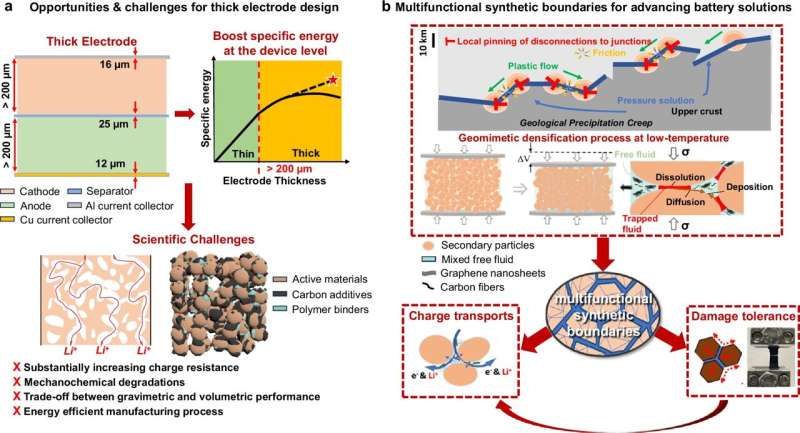Electrodes are the veins of batteries, responsible for harnessing and transporting the lifeblood of energy storage devices: electricity. Battery power and efficiency largely hinge on the performance of these electrodes—and now a team led by researchers at Penn State has created a new design that holds promise for practical applications like mobile electronics and electric vehicles.
The team recently developed dense, thick electrodes with substantially improved cell-level charge capacity, while also enhancing mechanical strength to withstand degradation during repeated battery charge cycles. By using a novel manufacturing process that increases electrode performance, the team overcame the drawbacks typically associated with increasing an electrode’s density and thickness.
The research was published today in Nature Communications.
According to Hongtao Sun, assistant professor of industrial and manufacturing engineering (IME) and principal investigator on the project, the key to improving batteries is increasing the amount of active material—the component that stores energy and impacts battery performance—in the electrodes.
“Traditionally, active material makes up only 30% to 50% of commercial battery cells,” Sun said. “By simply making the electrode thicker, we can increase the overall amount of active material and boost the total energy of the battery.”
Sun, who holds additional affiliations in biomedical engineering, materials science and engineering, and the Materials Research Institute at Penn State, explained that increasing electrode thickness typically requires making the structure highly porous—more than 40% empty space—to allow charges to easily move around.
However, that extra porosity reduces how much active material and, in turn, energy the battery can store overall. Although packing the electrodes more densely seems like an obvious solution to increase power, Sun explained how the compacted structure restricts charge transport, weakening the battery’s performance.
To overcome this trade-off, Sun’s team designed synthetic boundaries within its electrodes, which act as a “reservoir” for charges and allows for quick travel across the system. Using these boundaries, the electrodes can be made five to 10 times thicker and twice as dense as conventional electrodes, significantly increasing energy density within a limited volume.

The resulting batteries demonstrated a potential energy density exceeding 500 watt-hours per kilogram at the cell level, a power level that could enable electric vehicles to achieve a much longer driving range per charge, according to Sun.
Sun said this strategy achieves an optimal balance between weight, thickness, volume and capacity, producing cell-level performance that exceeds today’s commercial electrodes.
“By creating a three-dimensional network of synthetic boundaries in our electrodes, we can increase the energy output while simultaneously increasing density and thickness, overcoming a limitation of current commercial electrodes,” Sun said.
Sun’s team used various liquid additives during densification, compressing and gradually heating the mixture to about 120 degrees Celsius (C)—a much lower temperature than traditional densification heats, which can reach 1,000 C. This low-energy densification process helped the team form the synthetic boundaries, consisting of a specialized poly-ionic liquid gel, within the electrodes.
Besides better performance, Sun explained how this approach yielded electrodes with substantial mechanical improvements.
“We were able to increase the toughness by a factor of 10 and improve the ultimate strength of the electrode by three times compared to hot-pressed electrodes made without a liquid additive,” Sun said, explaining the team developed digital imaging correlation as tool to monitor the strain response of electrodes in real time during battery operation.
Unlike complex synchrotron-based techniques, this method is affordable with standard laboratory equipment, offering researchers a practical way to visualize and study how batteries degrade.
According to Sun, battery electrodes often wear out over time because of the dynamic stress created by repeated charging and discharging—damage that is very noticeable in devices like mobile phones, where batteries undergo a charging cycle almost daily. By increasing the damage tolerance of its electrodes, the team’s batteries are not as impacted by charge cycles, greatly extending their effective life.
Sun said the team’s electrode manufacturing technique is affordable, scalable to industrial applications and compatible with standard equipment. The researchers seek to scale their electrode manufacturing for commercialization, planning to transition the technique from batch-scale production, which only allows for a specific, low-volume number of electrodes to be assembled at a time, to continuous roll-to-roll manufacturing. This system would incorporate pressure- and temperature-controlled rollers, along with built-in quality control tools, to enable large-scale production of the team’s improved electrodes.
More information:
Bo Nie et al, Unveiling multifunctional synthetic boundaries for enhanced mechanical and electrochemical performance in densified thick composite electrodes, Nature Communications (2025). DOI: 10.1038/s41467-025-65257-2
Citation:
Bridging boundaries: Dense, thick electrodes pack more energy into batteries (2025, October 29)
retrieved 29 October 2025
from https://techxplore.com/news/2025-10-bridging-boundaries-dense-thick-electrodes.html
This document is subject to copyright. Apart from any fair dealing for the purpose of private study or research, no
part may be reproduced without the written permission. The content is provided for information purposes only.

